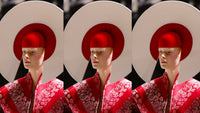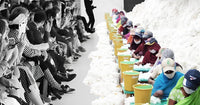As fashion industry is undergoing a alternative transformation, driven by the need for sustainability and innovation, new methods in creating textiles from other resources are constantly being tested and developed. At the forefront of this change are bio textiles, bio plastics, and 3D printing - that are transforming the idea of fashion by offering not only sustainable options but also unlocking new realms of creativity. Bio textiles, grown from living organisms like algae, and bio plastics, derived from renewable resources, provide designers with novel materials that challenge traditional textile boundaries. 3D printing, meanwhile, opens up possibilities for intricate, customizable designs that were previously unimaginable. These innovations allow for experimental shapes, textures, and techniques that push the artistic limits of fashion, enabling designers to explore alternative aesthetics and methods of garment-making beyond just environmental benefits.
OPEN STUDIO
Fight or Flight and Paper Gallery Prishtina
During October and November 2024, Paper Gallery in Prishtina will host the open studio, titled 'Symbiotic Thread: Organic Fashion Future', where Fight or Flight Studio designers will explore the process of creating bio textiles, bio plastics, and 3D-printed textile, investigating the evolving relationship between organic materials and traditional textiles, and how these new materials challenge and redefine the boundaries between nature, humanity, and technology in fashion design.
Drawing inspiration from Wilhelm Worringer's "Abstraction and Empathy”, the work at the open studio which will be concluded in a exhibition, explores how abstract and advanced materials can work together with our natural and human connections and aims to understand the emotional and conceptual impact of these innovative materials in fashion.
Key Elements during the Open Studio and References
Bio Textile
Created through biological processes, blending life and design. This textile is closely linked to the natural world, evoking strong emotions through its organic origins and textures. Created through biological processes, such as growing fabrics from living organisms like bacteria, algae, or fungi, this breakthrough method not only reduces the reliance on petroleum-based textiles but also promotes circularity in fashion, as bio textiles are often biodegradable or compostable. Their natural origins also evoke emotional connections, bringing fashion closer to nature.
Fun fact:
Susan Lee is the bio textile pioneer, who coined the term ‘Biocouture™’

Bomber Jacket made by Susan Lee, using bio leather
Bio Plastics
Can be made in domestic environment, serving as a bridge between the synthetic and the organic. Using renewable resources like starch or algae, not only reduces reliance on traditional, synthetic materials but also offer a versatile medium for reimagining accessories, footwear, and even entire garments. Its adaptability allows for creative expression, as they can be molded into complex shapes and designs that traditional fabrics can’t achieve.
3D printed textile
3D Printing in fashion is revolutionizing how garments are made, offering precise, on-demand production that minimizes waste. It provides unmatched precision and flexibility, making it possible to craft complex patterns and architectural forms that challenge the limits of traditional sewing techniques.
Organic vs. Traditional Textiles
The open studio juxtaposes bio-fabricated materials with traditional textiles, creating a dialogue that explores the environmental, cultural, and aesthetic implications of both. This relationship mirrors Worringer’s dichotomy, where abstraction in material design is balanced by the empathetic connection to nature and fashion tradition.
Open Studio
Designer: Hana Zeqa
Assistant designer: Rita Hasani
Paper Gallery
19.09 - 04.11.2024
weekdays
10:00 - 16:00







